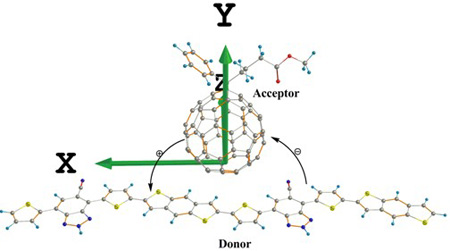[1] (a) Cho, S.; Lee, J.; Tong, M. H.; Seo, J. H.; Yang, C. Adv. Funct. Mater. 2011, 21, 1910; (b) Chen, L.; Shen, X.; Chen, Y. Chin. J. Chem. 2012, 30, 2219; (c) Loser, S.; Bruns, C. J.; Miyauchi, H.; Ortiz, R. P.; Facchetti, A.; Stupp, S. I.; Marks, T. J. J. Am. Chem. Soc. 2011, 133, 8142; (d) Zhuo, Z.-L.; Zhang, F.-J.; Xu, X.-W.; Wang, J.; Lu, L.-F.; Xu, Z. Acta Phys.-Chim. Sin. 2011, 27, 875. (卓祖亮, 张福俊, 许晓伟, 王健, 卢丽芳, 徐征, 物理化学学报, 2011, 27, 875.); (e) Ye, H.; Li, W.; Li, W. Chin. J. Org. Chem. 2012, 32, 266. (叶怀英, 李文, 李维实, 有机化学, 2012, 32, 266.)
[2] Zhang, J.; Deng, D.; He, C.; He, Y.; Zhang, M.; Zhang, Z.-G.; Zhang, Z.; Li, Y. Chem. Mater. 2011, 23, 817.
[3] Li, Y.; Pullerits, T.; Zhao, M.; Sun, M. J. Phys. Chem. C 2011, 115, 21865.
[4] (a) Walker, B.; Kim, C.; Nguyen, T.-Q. Chem. Mater. 2011, 23, 470; (b) Pappenfus, T. M.; Schmidt, J. A.; Koehn, R. E.; Alia, J. D. Macromolecules 2011, 44, 2354; (c) Zhang, T.; Piao, L.; Zhao, S.; Xu, Z.; Yang, L.; Liu, X.; Ju, S. Chin. J. Org. Chem. 2011, 31, 260. (张天慧, 朴玲钰, 赵谡玲, 徐征, 杨磊, 刘祥志, 鞠思婷, 有机化学, 2011, 31, 260.)
[5] (a) Yi, Y.; Coropceanu, V.; Brédas, J.-L. J. Mater. Chem. 2011, 21, 1479; (b) Chen, Z. X.; Huang, Y. C.; Li, Z.; Kang, G. J. Prog. Chem. 2009, 21, 2271. (陈兆旭, 黄玉成, 李哲, 康国俊, 化学进展, 2009, 21, 2271.)
[6] (a) Blouin, N.; Michaud, A.; Gendron, D.; Wakim, S.; Blair, E.; Neagu-Plesu, R.; Belletête, M.; Durocher, G.; Tao, Y.; Leclerc, M. J. Am. Chem. Soc. 2008, 130, 732; (b) Mikroyannidis, J. A.; Sharma, S. S.; Vijay, Y. K.; Sharma, G. D. Appl. Mater. Interfaces 2010, 2(1), 270.
[7] (a) Tang, S. S.; Zhang, J. P. J. Phys. Chem. A 2011, 115, 5184; (b) Shang, H.; Fan, H.; Shi, Q.; Li, S.; Li, Y.; Zhan, X. Solar Energy Materials & Solar Cells 2010, 94, 457; (c) Beaupré, S.; Belletête, M.; Durocher, G.; Leclerc, M. Macromol. Theory Simul. 2011, 20, 13.
[8] Shang, H.; Fan, H.; Liu, Y.; Hu, W.; Li, Y.; Zhan, X. Adv. Mater. 2011, 23, 1554.
[9] Price, S. C.; Stuart, A. C.; Yang, L.; Zhou, H.; You, W. J. Am. Chem. Soc. 2011, 133, 4625.
[10] Frisch, M. J.; Trucks, G. W.; Schlegel, H. B.; Scuseria, G. E.; Robb, M. A.; Cheeseman, J. R.; Scalmani, G.; Barone, V.; Mennucci, B.; Petersson, G. A.; Nakatsuji, H.; Caricato, M.; Li, X.; Hratchian, H. P.; Izmaylov, A. F.; Bloino, J.; Zheng, G.; Sonnenberg, J. L.; Hada, M.; Ehara, M.; Toyota, K.; Fukuda, R.; Hasegawa, J.; Ishida, M.; Nakajima, T.; Honda, Y.; Kitao, O.; Nakai, H.; Vreven, T.; Montgomery, Jr., J. A.; Peralta, J. E.; Ogliaro, F.; Bearpark, M.; Heyd, J. J.; Brothers, E.; Kudin, K. N.; Staroverov, V. N.; Kobayashi, R.; Normand, J.; Raghavachari, K.; Rendell, A.; Burant, J. C.; Iyengar, S. S.; Tomasi, J.; Cossi, M.; Rega, N.; Millam, N. J.; Klene,M.; Knox, J. E.; Cross, J. B.; Bakken, V.; Adamo, C.; Jaramillo, J.; Gomperts, R.; Stratmann, R. E.; Yazyev, O.; Austin, A. J.; Cammi, R.; Pomelli, C.; Ochterski, J. W.; Martin, R. L.; Morokuma, K.; Zakrzewski, V. G.; Voth, G. A.; Salvador, P.; Dannenberg, J. J.; Dapprich, S.; Daniels, A. D.; Farkas, ?. O.; Foresman, J. B.; Ortiz, J. V.; Cioslowski, J.; Fox, D. J. Gaussian 09, Revision A.01, Gaussian, Inc., Wallingford, CT, 2009.
[11] (a) Becke, A. D. J. Chem. Phys. 1993, 98, 5648; (b) Lee, C.; Yang, W.; Parr, R. G. Phys. Rev. B 1988, 37, 785; (c) Cohen, A. J.; Mori-Sánchez, P.; Yang, W. T. Chem. Rev. 2012, 112, 289.
[12] (a) Perdew, J. P.; Burke, K.; Ernzerhof, M. Phys. Rev. Lett. 1997, 78, 1396; (b) Sun, L.; Bai, F.-Q.; Zhao, Z.-X.; Zhang, H.-X. Solar Energy Materials & Solar Cells 2011, 95, 1800.
[13] Lu, T. Multiwfn, version 2.1, http://multiwfn.codeplex.com/
[14] (a) Marcus, R. A. Rev. Mod. Phys. 1993, 65, 599; (b) Marcus, R. A. Ann. Rev. Phys. Chem. 1964, 15, 155.
[15] (a) Cave, R. J.; Newton, M. D. J. Chem. Phys. 1997, 106, 9213; (b) Cave, R. J.; Newton, M. D. Chem. Phys. Lett. 1996, 249, 15.
[16] (a) Bijleveld, J. C.; Verstrijden, R. A. M.; Wienk, M. M.; Janssen, R. A. J. Appl. Phys. Lett. 2010, 97, 073304 (1—3); (b) Scharber, M. C.; Mühlbacher, D.; Koppe, M.; Denk, P.; Waldauf, C.; Heeger, A. J.; Brabec, C. J. Adv. Mater. 2006, 18(6), 789.
[17] Rand, B. P.; Genoe, J.; Heremans, P.; Poortmans, J. Prog. Photovolt: Res. Appl. 2007, 15, 659.
[18] Zhen, C.-G.; Becker, U.; Kieffer, J. J. Phys. Chem. A 2009, 113, 9707.
[19] Vooren, A. V.; Lemaur, V.; Ye, A.; Beljonne, D.; Cornil, J. Chem. Phys. Chem. 2007, 8, 1240.
[20] D’Souza, F.; Chitta, R.; Ohkubo, K.; Tasior, M.; Subbaiyan, N. K.; Zandler, M. E.; Rogacki, M. K.; Gryko, D. T.; Fukuzumi, S. J. Am. Chem. Soc. 2008, 130, 14263.
[21] Shen, F.; Peng, A.; Chen, Y.; Dong, Y.; Jiang, Z.; Wang, Y.; Fu, H.; Yao, J. J. Phys. Chem. A 2008, 112, 2206.
[22] Shang, Y.; Li, Q.; Meng, L.; Wang, D.; Shuai, Z. Theor. Chem. Acc. 2011, 129, 291.
[23] Deng, W.-Q.; Goddard Ⅲ, W. A. J. Phys. Chem. B 2004, 108, 8614.
[24] Lan, Y.-K.; Huang, C.-I. J. Phys. Chem. B 2008, 112, 14857.
[25] (a) Han, L. Z.; Wang, Z.; Hua, Y. J.; Ren, A. M.; Liu, Y. L.; Liu, P. J. Acta Chim. Sinica 2012, 70, 579. (韩立志, 王卓, 华英杰, 任爱民, 刘艳玲, 刘朋军, 化学学报, 2012, 70, 579.); (b) Ren, X.-F.; Ren, A.-M.; Feng, J.-K.; Sun, C.-C. J. Photochem. Photobiol. A: Chem. 2009, 203, 92. |
